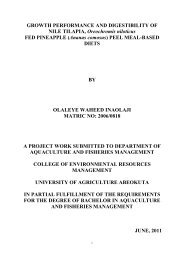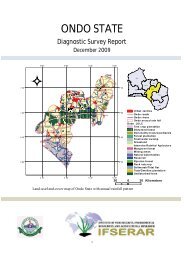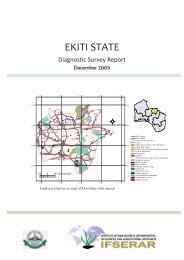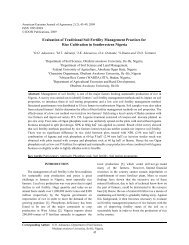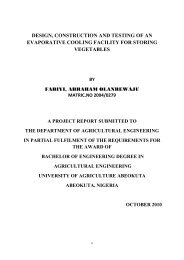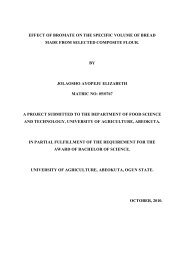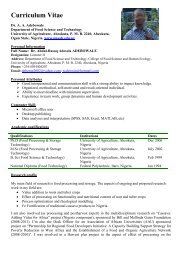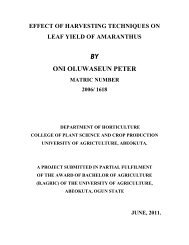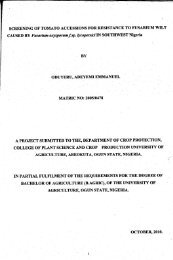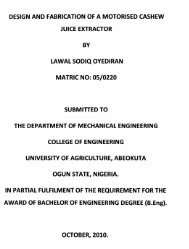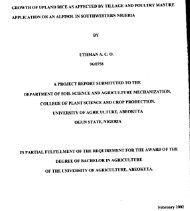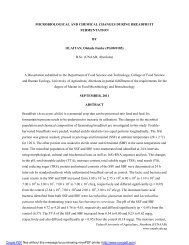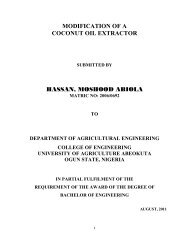classification of upper slope soils of a toposequence for rainfed ...
classification of upper slope soils of a toposequence for rainfed ...
classification of upper slope soils of a toposequence for rainfed ...
Create successful ePaper yourself
Turn your PDF publications into a flip-book with our unique Google optimized e-Paper software.
CLASSIFICATION OF UPPER SLOPE SOILS OF A TOPOSEQUENCE<br />
FOR RAINFED ARABLE CROPS (YAM, CASSA VA, MAIZE) IN<br />
UNIVERSITY OF AGRICULTURE, ABEOKUTA (COLANIM FARM)<br />
OKE FELIX ABIOLA<br />
MATRIC NO. 01/1230<br />
A PROJECT SUBMITTED TO THE DEPARTMENT OF SOIL SCIENCE<br />
AND LAND MANAGEMENT,<br />
UNIVERSITY OF AGRICULTURE ABEOKUTA<br />
IN PARTIAL FULFILLMENT OF THE REQUIREMENT FOR THE<br />
AWARD OF BACHELOR OF AGRICULTURE
Detai led soi I and land maps <strong>of</strong> an area approximately 32.592ha, along a representative<br />
topographic location in the University <strong>of</strong> Agriculture, Abeokuta were produced <strong>for</strong> effective<br />
land use planning.<br />
The site is underlain by basement complex rock with quartz, schists, coarse grained and fined<br />
grained and gneissis as parent material. Three (3) soil series were identified with soil<br />
properties varying within short distance. Soil textural class ranges from sandyloam to sandy<br />
clayloam with parent gravel ranging from 0.8 - 76.3<br />
Soil reaction is slightly acidic to strong acid (PH 5.46 - 6.32) with moderate to high<br />
phosphorus (10.41 - 57.77)mg/kg and high base saturation (77.95 - n94.34)%. The<br />
coefficient <strong>of</strong> variability <strong>for</strong> soil properties ranging from (1.10 - 37.75%) with 18.71% foe<br />
available phosphorus, 16.34 <strong>for</strong> Ca++ and 37.75 <strong>for</strong> % gravel, 9.07 % <strong>for</strong> %OC, 9.48% organic<br />
matter, j.41<br />
<strong>for</strong> % base saturation<br />
Soil productivity indices <strong>for</strong> <strong>rainfed</strong> arable crops (yam, cassava and maize were developed <strong>for</strong><br />
the three (3) soil series (Alfisol) in the area. It involved ratings <strong>of</strong> relevant soil characteristics<br />
and using the ratings to calculate soil productivity index and soil fertility index. Actual<br />
productivity index (p) is the product <strong>of</strong> the rating <strong>for</strong> soil depth (d), texture (t), <strong>slope</strong>s (s), soil<br />
fertility index (f) and annual rainfall (w). The soil fertility index (f) is the product <strong>of</strong> rating<br />
<strong>for</strong> nutrients (Pn), organic matter ( I' ), base saturation (n), nature <strong>of</strong> clay minerals (e) and<br />
mineral reserve (m). Potential productivity index (PI) is the product <strong>of</strong> soil depth (d), texture
(t), <strong>slope</strong> (s), mineral reserve (m) and nature <strong>of</strong> clay (a). Coefficient <strong>of</strong> improvelnent is C =<br />
P/p<br />
Egbeda and lwo are recommended <strong>for</strong> cassava, maize and yam while Ibadan is recommended<br />
<strong>for</strong> maize. Land suitability <strong>classification</strong> is however essential <strong>for</strong> optimum crop production<br />
and soil management. The soil was classified into Afisols and Luvisol <strong>of</strong> the USDA soil<br />
c1assi fication with corresponding FAO soil <strong>classification</strong>.



